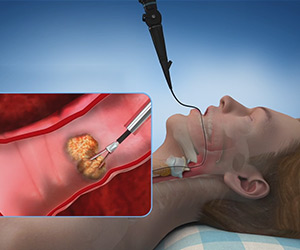What is Bronchoscopy?
Bronchoscopy is a procedure used to evaluate the airways, lungs or lymph nodes in the chest for abnormalities and to treat conditions such as abnormal growths or foreign bodies causing airway obstruction.

Types
There are two types of bronchoscopes that may be used: Flexible and Rigid.
Flexible bronchoscopy uses a long, thin, flexible lighted tube that can access the small airway branches. A sample of tissue or a biopsy may be obtained through the bronchoscope for laboratory study.
Rigid bronchoscopy involves the use of a rigid, straight, hollow metal tube. Rigid bronchoscopy is indicated when the airway is obstructed by blood or foreign objects.
Indications
Bronchoscopy is commonly performed to evaluate abnormal findings on a chest X-ray or CT scan and obtain biopsies for further studies. It may also be used to diagnose airway problems such as:
- A Persistent cough.
- Difficulty breathing.
- Blood in the sputum and.
- Lung cancer.
Pre-procedural preparation
Inform your doctor if you are pregnant or allergic to any medications. Other tests may also be ordered prior to the procedure. To reduce the risk of bleeding, you will have to discontinue taking blood thinning medications and non-steroidal anti-inflammatory drugs a few days before the procedure. You should abstain from food and drink after midnight before the procedure and if instructed to take medications, you should do so only with a sip of water.
Procedure
During a bronchoscopy, your blood pressure, oxygen level and heart rate are continually monitored.
Flexible bronchoscopy may be performed with you lying on your back or in a reclined or upright position. A sedative will be administered to help you relax and an intravenous line will be inserted for additional medications. A local anesthetic will be sprayed into your nose and mouth to reduce your gag reflex and minimize discomfort from insertion of the bronchoscope. In case of narrow nasal passages, the tube may be inserted through your mouth. The bronchoscope is gently inserted past the vocal cords and trachea into your lung while your doctor looks for abnormalities. Instruments are passed through the bronchoscope and guided by X-ray imaging to obtain tissue and fluid samples or to perform other procedures. Your airway will then be washed with a saline solution.
A rigid bronchoscopy is performed under general anesthesia. Your neck is extended and the bronchoscope is gently inserted through your mouth and windpipe. Biopsy samples are obtained and the airway is washed with saline.
Post-Procedural Care
Following the procedure, you should avoid drinking or eating for at least 2 hours. Starting with small sips of water you can then gradually resume a normal diet. Avoid smoking for at least 24 hours after the procedure. You should not drive, drink alcohol or operate machinery for 24 hours after receiving the sedative. You may experience a sore throat which can be soothed by warm salt water gargles or throat lozenges. Consult your doctor immediately if you have breathing problems, persistent fever, or significant bleeding.
Risks and Complications
Bronchoscopy is generally a safe test but as with any procedure complications may occur and can include:
- Breathing impairment.
- Arrhythmias or irregular heart rhythms.
- Infection such as pneumonia.
- Hoarseness.
- Tear in the lung or bleeding due to a biopsy instrument.
